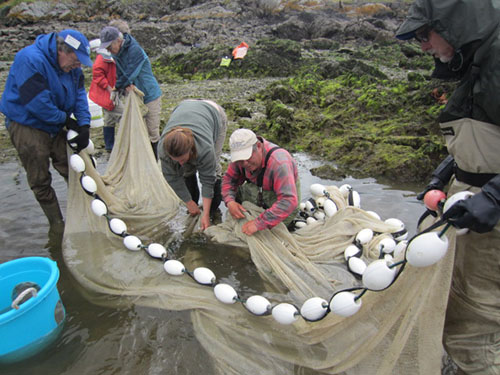— from Russel Barsh —
 The Indian Island Marine Health Observatory, a volunteer monitoring and stewardship program, is the beneficiary of Doe Bay Resort’s Open-Mic Thursday nights in January. Every pizza you eat helps put more volunteers on the beach!
The Indian Island Marine Health Observatory, a volunteer monitoring and stewardship program, is the beneficiary of Doe Bay Resort’s Open-Mic Thursday nights in January. Every pizza you eat helps put more volunteers on the beach!
Indian Island is Eastsound’s “window on the sea”: four acres of tide pools, bluffs, wildflower meadows, kelp and eelgrass that are accessible by foot on spring and summer low tide days. Over six thousand people visit the island each year, a boon for Eastsound businesses and a growing challenge for local volunteer stewards.
Data collected over the past eight years have also confirmed that tide pool animals such as crabs and sea stars are declining. Some of the decline can be attributed to warmer summer weather, but the decline is greatest in parts of the beach that are most popular with visitors.
“Our visitors don’t leave trash or beach fires,” says Russel Barsh of Kwiaht, the nonprofit organization that sponsors the Indian Island Marine Health Observatory. “The simple fact is that birds, wildflowers and tide pools can only survive so much disturbance a year. It helps if people are more careful about where they step, leave tide-pool animals attached to rocks, don’t roll over boulders, and keep their distance from birds’ nests.” The best way to promote good behavior, he says, is through face-to-face interaction of visitors with informed local volunteers.
At some times of the year there no choice but to steer visitors away from sensitive parts of the island, Barsh says. “Signs do help, but we find that the presence of courteous, well-informed local volunteers brings compliance up close to a hundred percent.”
Five years after volunteers marked out a single narrow trail to the highest point on the island with driftwood, the wildflower display in spring is the equal of Yellow Island, says Barsh. “It’s now a continuous quilt of blue Camas and pink Sea Blush with patches of Chocolate Lilies, changing to yellow Gumweed, sedum and pink native onions, and finally pearly white Rein Orchids by July.” Thickets of Garry Oak are also thriving.
Nesting birds such as Black Oystercatchers, Killdeer, White Crowned Sparrows, and Rough-Winged Swallows are especially wary of people and pets. The number of bird nests and fledged chicks at Indian Island has actually increased since volunteers began to discourage visits to the meadow
Kwiaht researchers have donated their time since 2009 to training volunteers and guiding the conservation program at Indian Island. Maintaining the volunteer presence at Indian Island for an average of 50 days each year also requires professional coordination. As the number of visitors and volunteers grows, Kwiaht must raise more money to help keep “boots on the beach”. The Orcas Island Community Foundation’s Christmas catalog has already raised half the money needed for summer 2017.
The one paid job at Indian Island has become an annual half-time apprenticeship for local high school and college students. “We believe this is a great opportunity to grow the next generation of conservation scientists and environmental engineers,” Barsh says, explaining that the job requires “a love of people and social skills as well as grounding in biology and ecology.”
Kwiaht also plans to offer a condensed weekend version of its popular 2015 ASK ME course on island ecology in March for current and prospective volunteers.
Open-Mic evenings will be hosted by Indian Island volunteers Michael Elder, Anne Bertino, David and Geri Turnoy, and Sarah Ross. Don’t miss your opportunity to support our stewardship of Indian Island by enjoying Open-Mic Thursdays at Doe Bay Resort this January.
**If you are reading theOrcasonian for free, thank your fellow islanders. If you would like to support theOrcasonian CLICK HERE to set your modestly-priced, voluntary subscription. Otherwise, no worries; we’re happy to share with you.**







